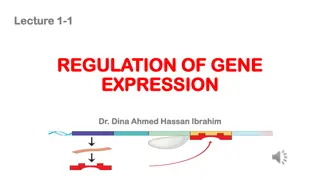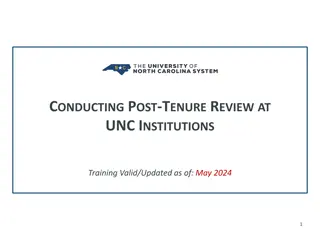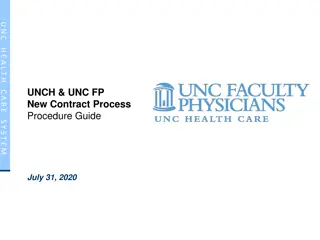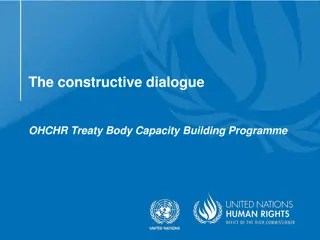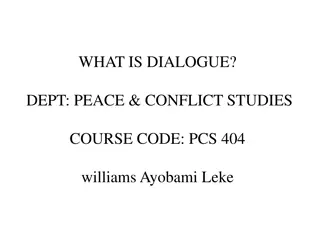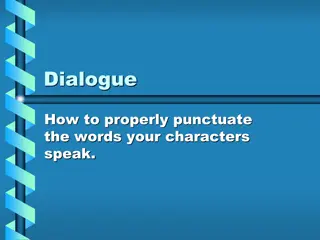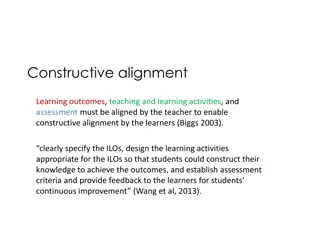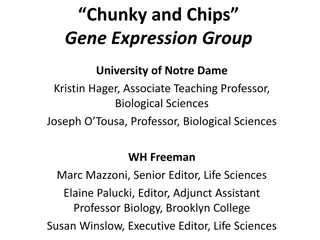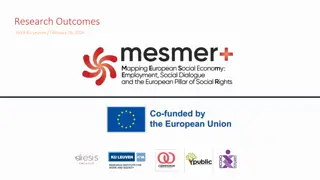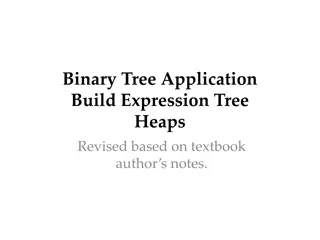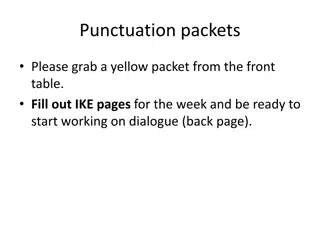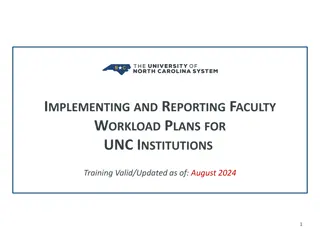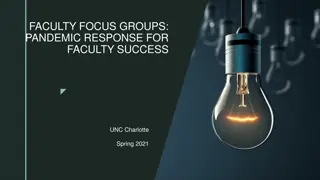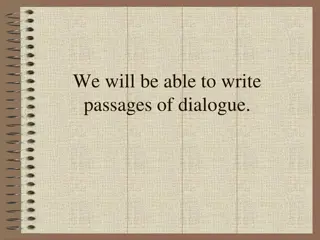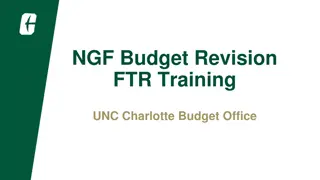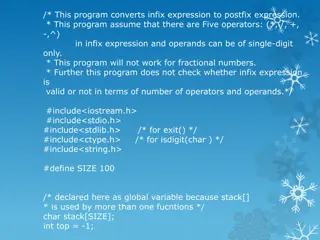Free Expression and Constructive Dialogue at UNC
This faculty-led project at the University of North Carolina explores the dynamics of free expression and constructive dialogue within the student community. Through rigorous research and analysis, the project aims to revisit key findings, identify areas for improvement, and enhance understanding of diverse perspectives on campus. Leveraging a comprehensive research approach, the project delves into faculty-student interactions, political discourse in classrooms, and more, shedding light on the culture of open dialogue and academic freedom at UNC.
Download Presentation

Please find below an Image/Link to download the presentation.
The content on the website is provided AS IS for your information and personal use only. It may not be sold, licensed, or shared on other websites without obtaining consent from the author. Download presentation by click this link. If you encounter any issues during the download, it is possible that the publisher has removed the file from their server.
E N D
Presentation Transcript
Free Expression and Constructive Dialogue at the University of North Carolina Timothy J. Ryan, UNC Chapel Hill Andrew M. Engelhardt, UNC-Greensboro Jennifer Larson, UNC-Chapel Hill Mark McNeilly, UNC-Chapel Hill
Background and objectives This is a faculty-led project. We build on the work we completed in 2019-2020. https://fecdsurveyreport.web.unc.edu/ The purposes of the renewed effort were to: Revisit findings with attention to variation across time and place. Push harder on standing questions. Begin to identify opportunities for improvement.
Research approach Participating institutions Participating institutions Appalachian State University NC Central University UNC-Asheville UNC-Chapel Hill UNC-Charlotte UNC-Greensboro UNC-Pembroke UNC-Wilmington Local research partners at each institution supported this work. We invited random samples of students at each institution to participate. Respondents were offered $10 to complete the survey. We met our target of 500 complete respondents at 5 out of 8 institutions. NC Central and UNC-P had a very low response rates. UNC-Asheville had a great response rate, but is a small school. Across schools, there were 3,408 complete responses.
Research approach The survey had two kinds of questions. Core content (~80% of survey length) was constant across schools. Modular content (~20% of survey length) was specific to each school. Local partners developed the modular content for their institution, with feedback from the PI. The samples generally come close to campus demographics. First-year students and women are slightly overrepresented. Not part of this presentation: A minority oversample (Black and Latino students) at UNC-Charlotte, initiated by Mel Atkinson. Coming up: A tasting menu : Four findings. Three questions and answers. There is a lot more in the report.
Finding 1: Faculty generally do not push political agendas Approach: Fly on the wall class sampling Percentage who disagreethat The course instructor encouraged participation from liberals and conservatives alike University University UNC-CH App NCCU UNC-A UNC-C UNC-G UNC-P UNC-W Respondent identifies as Liberal Moderate Conservative Note: Analysis is limited to the 36% of courses where the respondent indicated politics came up in class.
Finding 1: Faculty generally do not push political agendas Approach: Fly on the wall class sampling Percentage who disagreethat The course instructor encouraged participation from liberals and conservatives alike University University UNC-CH App NCCU UNC-A UNC-C UNC-G UNC-P UNC-W Respondent identifies as Liberal Moderate Conservative 6 6 7 13 8 -- 2 6 11 2 0 11 2 7 9 6 8 16 2 21 10 3 6 12 Note: Analysis is limited to the 36% of courses where the respondent indicated politics came up in class.
Finding 2: Campuses do not consistently achieve an atmosphere that promotes free expression Approach: Fly on the wall class sampling Percentage of students with various concerns University University UNC-CH App NCCU UNC-A UNC-C UNC-G UNC-P UNC-W Concerned about peers Concerned about instructor instructor Self-censored more than once peers Note: Analysis is limited to the 36% of courses where the respondent indicated politics came up in class.
Finding 2: Campuses do not consistently achieve an atmosphere that promotes free expression Approach: Fly on the wall class sampling Percentage of students with various concerns University University UNC-CH App NCCU UNC-A UNC-C UNC-G UNC-P UNC-W Concerned about peers Concerned about instructor instructor Self-censored more than once 39% 13% 31% 35% 37% 21% 25% 37% peers 22 13 15 24 18 14 20 22 22 17 21 18 22 17 17 22 Note: Analysis is limited to the 36% of courses where the respondent indicated politics came up in class.
Finding 3: Students who identify as conservative face distinctive challenges There are large liberal/moderate/conservative divides related to expression concerns (see report). We also measured students willingness to socialize with political outgroups.
Finding 4: Students across the political spectrum want more opportunities to engage with those who think differently UNC UNC- -CH CH There are too few opportunities to hear liberal speakers At 5 universities, majorities indicate that there are too few opportunities for constructive engagement. Liberals 21% Moderates 14 Students exhibit substantial enthusiasm for increasing opportunities to hear conservative speakers. This often includes a majority of students who describe themselves as moderate. Among students who identify as liberal, there is often more support for inviting more conservative speakers than for inviting more liberal speakers (6 universities). Conservatives 8 There are too few opportunities to hear conservative speakers Liberals 32% Moderates 56 Conservatives 86 Table shows the percentage of students who agree
What are students uncomfortable discussing? Proportion uncomfortable giving honest Proportion uncomfortable giving honest opinions in class, for various issues opinions in class, for various issues Answer: The things you d expect. But not onlythe things you d expect. The open-ended responses reveal some of the Rashomon moments that unfold on campus. Blue bars: Self-described liberals Green bars: Self-described moderates Red bars: Self-described conservatives
Who is engaged? More open More open- -minded students are minded students are less likely to be engaged less likely to be engaged Answer: Not necessarily who we hoped. Highly-engaged students tend to be: Less open-minded. Less adept at perspective taking. More likely to harbor negative stereotypes. And more (see report). For students whose opinions are more tentative, these trends can make engagement less appealing.
How can culture be improved? Focusing on consensus increases Focusing on consensus increases appeal to open appeal to open- -minded students minded students Answer: Trust and rapport. We find evidence that students are much more comfortable discussing politics in familiar settings. (See report.) We measured appeal of an event described in two different ways: The speakers would defend their points of view, criticize the other side s record, and try to persuade the audience to support their preferred policies. The speakers would present their points of view, consider the other side s record, and try to identify points of consensus and agreement?
The BPC Roadmap offers a holistic, strategic framework for building a free expression & constructive dialogue culture. It also enables customization by each campus to meet their unique environments and assess their progress. Areas Areas Chancellors/Provosts Example Recommendations Example Recommendations Define a free expression/constructive dialogue strategy and culture Model free expression and teach constructive dialogue Determine which issues are appropriate to take a stance on Prepare to support academic freedom when controversies occur Publicly support free expression and constructive dialogue Support research into free expression, viewpoint diversity, etc. Support/model free expression in the classroom and beyond Promote/model evidence-based argument Support athletes free expression rights Utilize orientation and other communications to build an understanding of students free speech rights and academic freedom Trustees Faculty Athletic Department Student Affairs Campus Free Expression: A New Roadmap | Bipartisan Policy Center. n.d. Bipartisanpolicy.org. November 30, 2021. https://bipartisanpolicy.org/report/a-new-roadmap/ 15
Thank you There is a lot more in the written report, and lots of opportunities for stakeholders to push the data further. Not part of this presentation: Campus-specific modules. Minority oversample at UNC-C. Please feel free to reach out: Timothy Ryan: tjr@email.unc.edu Andrew Engelhardt: amengelhard@uncg.edu Jennifer Larson: jlarson@email.unc.edu Mark McNeilly: Mark_McNeilly@kenan-flagler.unc.edu
Indoctrination? Were not very good at it. Perceived ideological change over time
Students worry about peers peers Percent concerned that, if they stated their sincere political views, professor professor would have a lower opinion University University A B C D E F G H Respondent identifies as Liberal Moderate Conservative 10 27 35 12 5 -- 9 14 43 12 21 57 8 8 7 13 36 11 13 22 9 21 37 42 Percent concerned that, if they stated their sincere political views, students students would have a lower opinion University University A B C D E F G H Respondent identifies as Liberal Moderate Conservative 27 38 57 11 10 -- 21 41 68 21 33 74 23 29 51 13 26 55 16 23 39 23 29 49
Students worry about peers peers Percent concerned that, if they stated their sincere political views, professor professor would have a lower opinion University University A B C D E F G H Respondent identifies as Liberal Moderate Conservative 10 27 35 12 5 -- 9 14 43 12 21 57 8 8 7 13 36 11 13 22 9 21 37 42 Percent concerned that, if they stated their sincere political views, students students would have a lower opinion University University A B C D E F G H Respondent identifies as Liberal Moderate Conservative 27 38 57 11 10 -- 21 41 68 21 33 74 23 29 51 13 26 55 16 23 39 23 29 49
Students worry about peers peers Percent concerned that, if they stated their sincere political views, professor professor would have a lower opinion University University A B C D E F G H Respondent identifies as Liberal Moderate Conservative 10 27 35 12 5 -- 9 14 43 12 21 57 8 8 7 13 36 11 13 22 9 21 37 42 Percent concerned that, if they stated their sincere political views, students students would have a lower opinion University University A B C D E F G H Respondent identifies as Liberal Moderate Conservative 27 38 57 11 10 -- 21 41 68 21 33 74 23 29 51 13 26 55 16 23 39 23 29 49
Students worry about peers peers Percent concerned that, if they stated their sincere political views, professor professor would have a lower opinion University University A B C D E F G H Respondent identifies as Liberal Moderate Conservative 10 27 35 12 5 -- 9 14 43 12 21 57 8 8 7 13 36 11 13 22 9 21 37 42 Percent concerned that, if they stated their sincere political views, students students would have a lower opinion University University A B C D E F G H Respondent identifies as Liberal Moderate Conservative 27 38 57 11 10 -- 21 41 68 21 33 74 23 29 51 13 26 55 16 23 39 23 29 49
Students worry about peers peers Percent concerned that, if they stated their sincere political views, professor professor would have a lower opinion University University A B C D E F G H Respondent identifies as Liberal Moderate Conservative 10 27 35 12 5 -- 9 14 43 12 21 57 8 8 7 13 36 11 13 22 9 21 37 42 Percent concerned that, if they stated their sincere political views, students students would have a lower opinion University University A B C D E F G H Respondent identifies as Liberal Moderate Conservative 27 38 57 11 10 -- 21 41 68 21 33 74 23 29 51 13 26 55 16 23 39 23 29 49
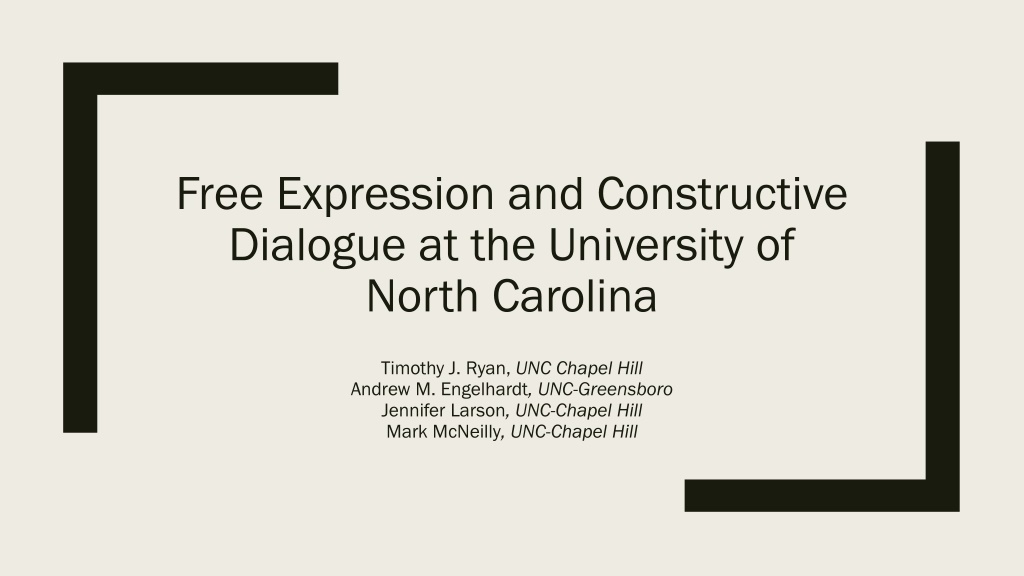
 undefined
undefined




